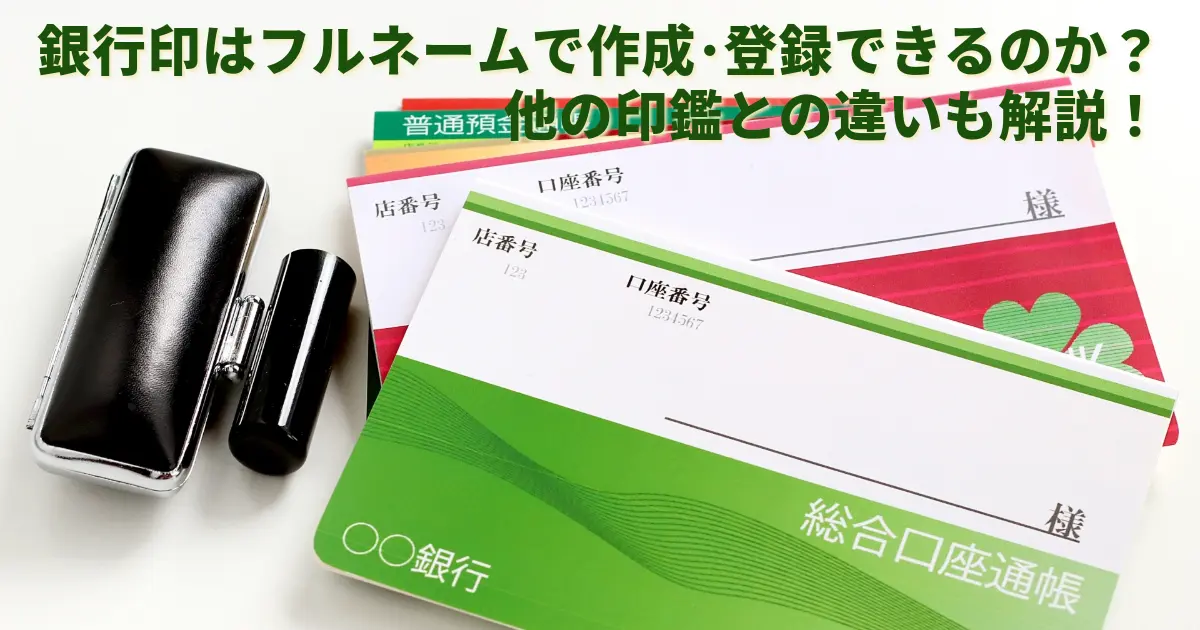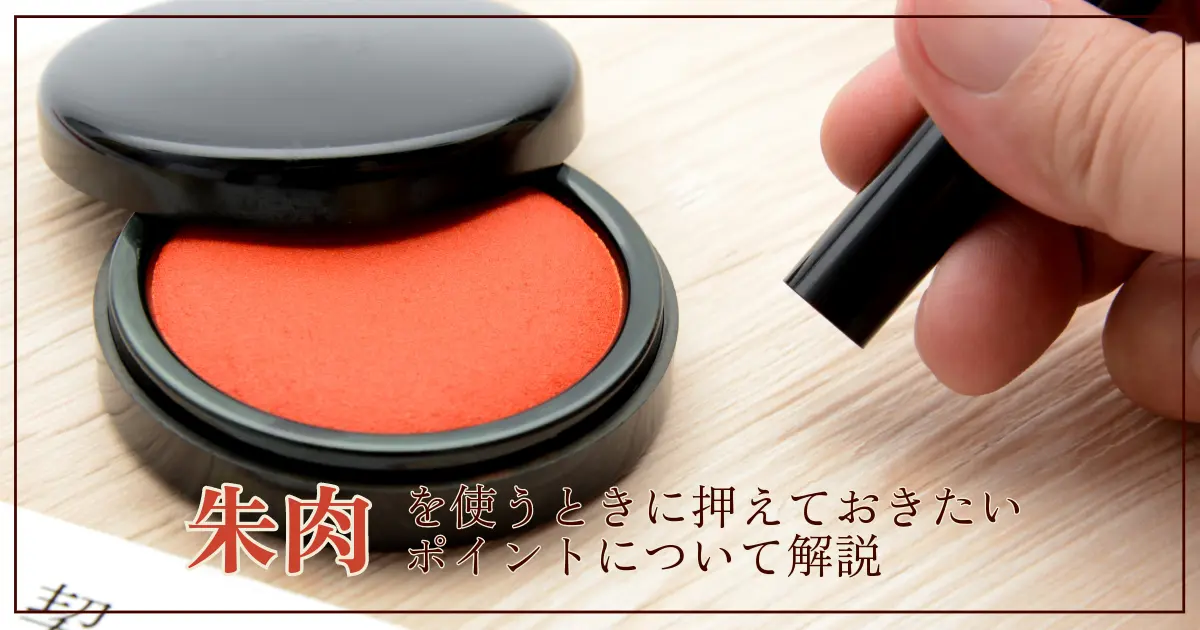There are various types of HANKO, including those used by individuals and those used by corporations. Many people know that bank seals are a type of HANKO, but they may not have much knowledge about their specific uses or how to create them. However, bank seals are very important HANKO for protecting the assets of individuals and corporations, and having accurate knowledge is essential.
The most common questions we receive are, ``Can I make a bank seal with my last name or my first name?'' and ``Can I make a bank seal with my full name?'' In most cases, a bank seal is created using your last name (surname), but it may also be created using your first name (first name) or full name (last name + first name) and registered when opening an account.
This time, we will give an overview of bank seals and explain how to create and register bank seals using your full name.
What is a bank seal?
A bank seal is a stamp that is registered with the bank when opening an account, and is mainly used by individuals and corporations when conducting banking business. Bank seals are stamped on various documents handled by banks to complete formal procedures, and are indispensable for important operations such as deposits and loans.
Bank seals are engraved with personal and corporate names, and are expected to be used only by the person holding the bank seal. In addition, bank stamps must be handled with care and must be careful not to be lost or stolen. Bank seals are subject to strict laws and regulations, and unauthorized use or improper management can be severely punished.
The locations where bank seals can be used are as follows:
- When performing procedures at a counter to withdraw cash from an account
- When applying for a credit card
- When creating a check or draft
- When opening an account at a financial institution (bank/shinkin bank)
In addition, a bank seal is required when changing previously submitted information, such as a change of address, branch office, or name change. By recognizing its purpose, you can avoid forgetting your bank stamp when you need it.
Difference from registered seal
A registered seal is a HANKO used to publicly certify an individual's decision-making.
Registered seals are used for house and car contracts, while bank seals are used specifically for banking procedures. It is less important than a registered seal because it is used for everyday purposes such as counter procedures.
Difference from a registered seal
Simply put, a registered seal is a HANKO that has not been registered.
A personal seal is a type of HANKO that is frequently used in daily life, and may be needed, for example, when receiving mail or submitting documents to business partners. Specifically, it is used for quotations, receipts, other external contracts, and internal approval documents.
Can I create and register a bank seal with my full name?
In conclusion, you can create and register a bank seal with your full name.
There are no strict regulations regarding the contents of the bank seal. Depending on the bank where you open an account, you can also register a designed HANKO with a picture on the face. If you would like to include an illustration on your bank seal, we recommend that you check with your bank in advance.
Advantages and disadvantages of creating a bank seal with your full name
There are advantages and disadvantages to creating a bank seal with your full name. By understanding this in advance, you can create a bank seal that you are satisfied with.
Advantages of creating a bank seal with your full name
There are three advantages to creating a bank seal with your full name:
merit
- Feels special
- Protection of personal information
- looks good
Feels special
Making a bank seal with your full name gives it a special feel.
Generally, a HANKO is created using your last name, so you can differentiate yourself from others. This will help the other person remember you and will be useful in communication situations. In addition, employees become aware that they have a special bank seal, which increases their motivation to work.
Protection of personal information
Creating a bank seal with your full name will help protect your personal information.
By using your full name on your bank seal, the design of the seal impression becomes more complex, protecting your personal information from forgery and unauthorized use. Also, by using your full name, it becomes clear who is using the bank seal.
looks good
Creating a bank seal with your full name will look better.
By using your full name on the bank seal, you can freely choose the design and image of the bank seal and create your own bank seal. Also, by using your full name, you can create a unique bank seal.
Disadvantages of creating a bank seal with your full name
There are three disadvantages to creating a bank seal using your full name:
Demerit
- too long
- complex and difficult to recognize
- Difficult to create by hand
too many characters
If you use your full name, the number of characters on the bank seal may be too many. Because bank seals are small in size, if you use a long full name, the characters may become small and difficult to read.
If the number of characters on your bank seal is too large, we recommend creating a bank seal with a larger size (diameter).
How to create and register a bank seal with your full name
How to create and register a bank seal with your full name
- Check full name
- Deciding on the material and size of the bank seal
- think about design
- Request a bank stamp shop
- Register bank seal
1. Check your full name
First, check your full legal name . Create a bank seal using the same name and last name as on your resident card, without using a common name.
2.Determine the material and size of the bank seal
Next, decide on the material and size of the bank seal. Bank seals are generally made of materials such as ivory, cow horn, or metal, and most are approximately 12 to 18 mm in diameter. Normally, bank seals are made a little smaller than registered seals, but in the case of full names, it is better to make them in a larger size so that the letters fit better.
3.Think about design
When using your full name as a bank seal, the design is also important. I like simple and clear designs. Also, if you want to create your own bank seal, you can be particular about the design. In addition to the design, we also decide on the engraving method and size material.
4. Request a bank stamp shop
Finally, ask a bank stamp shop to make a bank stamp. At a bank stamp shop, you can either come up with your own design and place an order, or you can order after looking at a sample at the store. Depending on the bank stamp shop, you may also be able to order online.
Direction of bank stamp
Bank seals are generally engraved horizontally.
When engraving a surname or name on the side of a bank seal, it is generally done so that it can be read from right to left. This is because the HANKO can be read smoothly when stamped.
5.Register your bank seal
Once you have created a bank seal, you need to register it with your bank or financial institution. The registration method differs depending on each bank or financial institution, so be sure to check in advance.
When opening accounts with multiple financial institutions, it is illegal to use the same bank seal multiple times. It will not be. However, from a security perspective, it is dangerous as it increases the risk of theft and duplication. Therefore, it is safer to register different bank seals for each financial institution. It is a hassle to separate bank seals, but it is better to do it just in case.
summary
We explained how to create and register a bank seal using your full name. If you understand the advantages and disadvantages of creating a bank seal using your full name, you can create a bank seal with confidence. A bank seal is not a HANKO that is made over and over again. Therefore, make sure to pay close attention to the creation method and design to create a bank seal that will last a lifetime.
 日本語
日本語 English
English 简体中文
简体中文 繁體中文
繁體中文 한국어
한국어 ไทย
ไทย Tiếng Việt
Tiếng Việt Indonesia
Indonesia Français
Français Español
Español Português
Português


